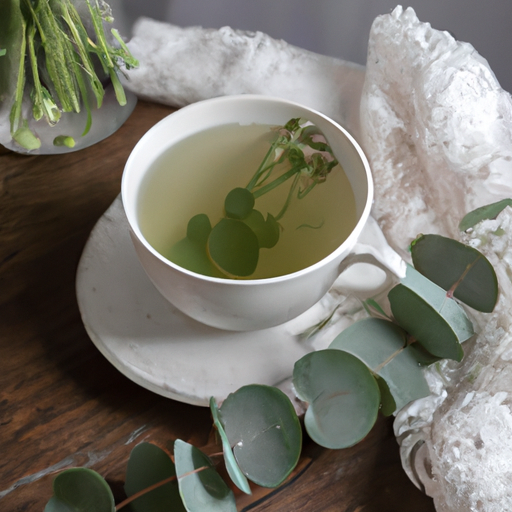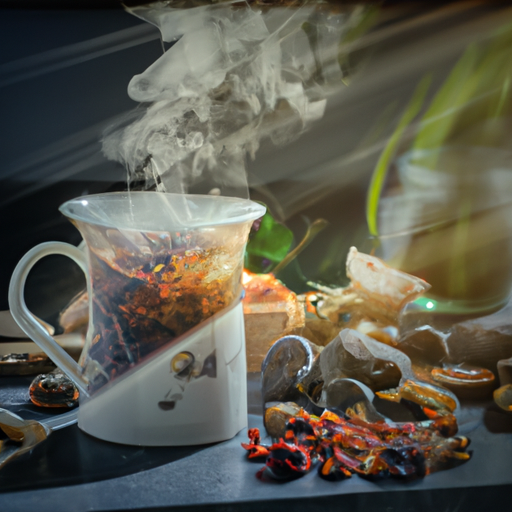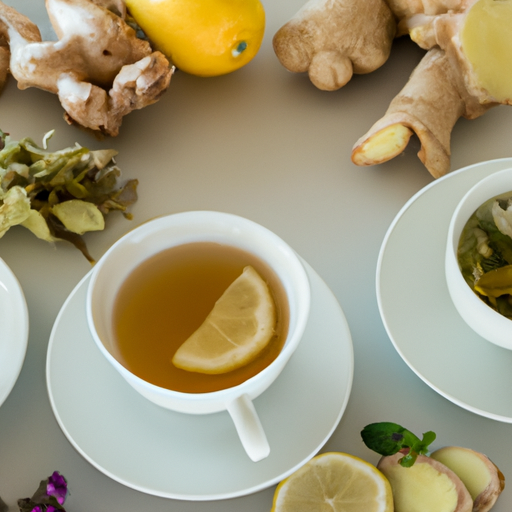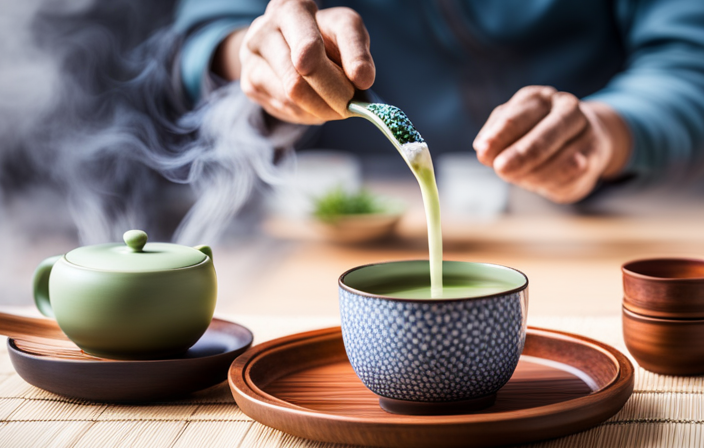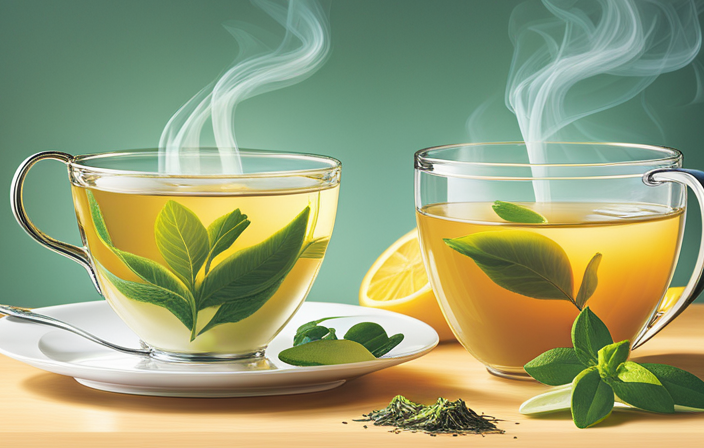Flower Tea
How To Dry Passion Flower Leaves For Tea

Have you ever wondered how to harness the soothing power of passion flower in a cup of tea? Look no further! In this article, I will guide you through the process of drying passion flower leaves for tea, ensuring you can enjoy the benefits of this magnificent plant all year round.
Passion flower tea is renowned for its calming properties, making it a popular choice for those seeking relief from stress and anxiety. By learning how to harvest and dry passion flower leaves properly, you can preserve their potency and create a delightful cup of tea whenever you desire.
In this comprehensive guide, I will explain the benefits of passion flower tea, teach you how to harvest the leaves, and provide detailed instructions on various drying methods. From sun drying to air drying, I will cover all the necessary steps to ensure your passion flower leaves are preserved perfectly.
So, grab your gardening gloves and get ready to embark on a journey of tea-making mastery as we explore the fascinating world of drying passion flower leaves for tea.
Key Takeaways
- Choose vibrant and undamaged leaves in the morning for harvesting passion flower leaves
- Dry passion flower leaves in a cool, dark, and well-ventilated area
- Alternative drying methods include using a dehydrator, air drying, or oven drying
- Store dried passion flower leaves in an airtight container in a cool, dark place
The Benefits of Passion Flower Tea
Did you know that passion flower tea offers numerous benefits for both your mind and body? Passion flower tea has long been recognized for its ability to help reduce anxiety and promote a sense of calm. The active compounds in passion flower, such as flavonoids and alkaloids, have been shown to have anxiolytic effects on the central nervous system, helping to alleviate feelings of stress and anxiety. It acts as a natural sedative, promoting relaxation and aiding in getting a good night’s sleep. Passion flower tea can be a great alternative for those who prefer natural remedies over prescription medications.
Passion flower tea is also believed to have sleep-enhancing properties. It helps to improve sleep quality by increasing levels of gamma-aminobutyric acid (GABA) in the brain, which has a calming effect on the nervous system. This can be particularly beneficial for individuals who struggle with insomnia or have difficulty falling asleep.
In addition to its anxiety-reducing and sleep-enhancing properties, passion flower tea is also rich in antioxidants, which help to protect the body against oxidative stress and damage caused by free radicals. These antioxidants can support overall health and well-being.
Now that we’ve explored the benefits of passion flower tea, let’s move on to the next section and learn how to harvest passion flower leaves for tea.
How to Harvest Passion Flower Leaves
When you pluck the delicate treasures from their vine, you’re creating a symphony of nature’s harmony, ready to be transformed into a soothing potion for your soul. Harvesting passion flower leaves is a delicate process that requires careful techniques to ensure the freshness and quality of the leaves. To begin, choose leaves that are vibrant in color and free from any signs of damage or disease. Gently grasp the stem near the base of the leaf and use a sharp pair of scissors to snip it off. Be sure not to tug or pull the leaf, as this can damage the plant.
To preserve the freshness of the leaves, it is best to harvest them in the morning when the dew has dried but before the heat of the day sets in. This ensures that the leaves contain the highest concentration of beneficial compounds. After harvesting, place the leaves in a basket or tray, taking care not to overcrowd them. This allows for proper air circulation and prevents moisture buildup, which can lead to mold or rot.
Preparing the leaves for drying is the next step in the process of creating passion flower tea.
Preparing the Leaves for Drying
To unleash the full potential of these exquisite treasures, gently handle the vibrant green foliage and carefully ready them for their transformative journey. When it comes to drying passion flower leaves for tea, it’s essential to preserve their vibrant color. One tip for preserving the color of dried passion flower leaves is to avoid exposing them to excessive heat or direct sunlight during the drying process. Instead, opt for a cool, dark, and well-ventilated area. This will help retain the natural green hue of the leaves.
Another alternative method for drying passion flower leaves is to use a dehydrator. Set the dehydrator to a low temperature, around 95°F (35°C), and place the leaves in a single layer on the trays. This method allows for a controlled drying process, ensuring the leaves maintain their color and flavor.
When the leaves have reached the desired crispness, it’s time to move on to the next step: choosing the right drying method. By carefully considering the various options available, you can ensure the best results for your passion flower tea.
Choosing the Right Drying Method
For optimal results, you’ll want to consider which drying method best suits your needs and preferences. There are different methods of drying herbs, each with its own advantages and disadvantages.
One popular method is air drying, which involves hanging the passion flower leaves upside down in a well-ventilated area. This allows the leaves to dry naturally over a period of time, typically two to three weeks. Air drying is a simple and cost-effective method, but it does require patience and proper air circulation to prevent mold or mildew from forming.
Another option is using a dehydrator, which is a machine designed specifically for drying fruits, vegetables, and herbs. Dehydrators provide a controlled environment with low heat and airflow, allowing the leaves to dry quickly while retaining their color and flavor. This method is ideal for those who want to dry large quantities of passion flower leaves or have a shorter drying time.
Aside from tea, dried passion flower leaves can be used in various alternative ways. They can be added to potpourri or used as a natural ingredient in homemade beauty products, such as bath salts or herbal sachets.
Now that you have an understanding of different drying methods, let’s move on to the next section about drying passion flower leaves in the sun.
Drying Passion Flower Leaves in the Sun
Bask in the warmth of the sun and let its radiant rays gently coax the essence of the passion flower into a state of sublime preservation. Drying passion flower leaves in the sun is one of the most common and effective methods for preserving their nutrients. This traditional approach harnesses the power of the sun’s natural heat and airflow to slowly remove moisture from the leaves while preserving their beneficial compounds.
To begin, gather fresh passion flower leaves that are free from any damage or discoloration. Choose a sunny day with low humidity to ensure optimal drying conditions. Lay the leaves in a single layer on a clean, dry surface, such as a mesh screen or a baking sheet. Make sure to place them in a well-ventilated area, away from direct sunlight to avoid any potential damage.
Throughout the drying process, it’s important to periodically flip the leaves to ensure even drying. This will prevent any moisture from being trapped, which can lead to mold or spoilage. Depending on the weather conditions, it may take anywhere from a few days to several weeks for the leaves to fully dry.
Once the leaves are crisp and brittle to the touch, they’re ready to be stored for future use. Gently transfer them to an airtight container, such as a glass jar or a resealable bag, and store them in a cool, dark place to maintain their quality.
Now, let’s explore another method for drying passion flower leaves: using an oven.
Using an Oven to Dry Passion Flower Leaves
Now that we’ve explored the process of drying passion flower leaves in the sun, let’s dive into another method: using an oven. When it comes to drying herbs, an oven can be a convenient and effective tool.
To begin, gather your freshly harvested passion flower leaves and gently rinse them under cool water. Pat them dry with a clean towel, ensuring there’s no excess moisture.
Next, preheat your oven to a low temperature, around 150°F (65°C). Place the leaves on a baking sheet in a single layer, making sure they’re not overlapping. This will allow for even drying.
Once your oven is preheated, place the baking sheet with the leaves inside. Keep the oven door slightly ajar to allow moisture to escape. Leave the leaves to dry for about 2-3 hours, checking periodically to make sure they’re not burning or becoming too crisp.
Alternatively, if you have a dehydrator, you can use it to dry passion flower leaves as well. Simply follow the manufacturer’s instructions for herb drying.
Using an oven or a dehydrator are both efficient methods for drying passion flower leaves, especially if you need them to be ready quickly. However, if you prefer a more traditional approach, the next section will discuss air drying passion flower leaves.
Air Drying Passion Flower Leaves
To air dry your passion flower leaves, all you need is a well-ventilated space and a little patience. This method is ideal for those who prefer a more natural and traditional way of drying herbs. Air drying allows the leaves to gradually lose moisture, preserving their flavor and medicinal properties. Here’s how you can do it:
-
Start by harvesting your passion flower leaves. Choose healthy and mature leaves, preferably in the morning when the plant’s oils are at their peak.
-
Gently rinse the leaves to remove any dirt or debris. Pat them dry with a clean towel.
-
Lay the leaves in a single layer on a clean and dry surface. It could be a wire mesh or a wooden drying rack. Ensure that the leaves have enough space around them for air circulation.
-
Place the drying rack in a well-ventilated area away from direct sunlight. A warm and dry room is ideal. Avoid humid spaces as they can prolong the drying time.
-
Allow the leaves to air dry completely. This process can take anywhere from 1 to 2 weeks, depending on the humidity levels.
Air drying is a simple and effective way to preserve the potency of passion flower leaves for tea. If you’re looking for alternative methods, you can also use a food dehydrator or an oven at a low temperature. These methods can expedite the drying process, but may slightly alter the flavor profile. Once your passion flower leaves are dried, it’s time to move on to the next step: storing them for future use.
Storing Dried Passion Flower Leaves
After air drying, you can store your dried passion flower leaves in an airtight container to maintain their flavor and medicinal properties for future use. Storing dried passion flower leaves properly is crucial in preserving their potency and ensuring they stay fresh for longer periods.
It is important to choose a container that can be tightly sealed to prevent moisture and air from entering. Mason jars or glass containers with rubber seals are ideal for this purpose. Make sure to label the container with the date of drying to keep track of their freshness.
Store the container in a cool, dark place, such as a pantry or cupboard, away from direct sunlight and heat. Exposure to light and heat can degrade the quality of the dried leaves. Additionally, avoid storing them near strong-smelling substances as passion flower leaves easily absorb odors.
When you’re ready to use the dried passion flower leaves, simply measure out the desired amount and reseal the container promptly. This will help maintain the remaining leaves’ freshness.
Now that you have your well-preserved dried passion flower leaves, let’s move on to brewing the perfect cup of passion flower tea, which will further enhance its calming effects without any additional steps.
Brewing the Perfect Cup of Passion Flower Tea
Indulge yourself in the comforting warmth and soothing aroma of a perfectly brewed cup of passion flower tea, allowing its calming effects to wash over you.
Brewing the perfect cup of passion flower tea is a delicate process that requires attention to detail and the use of proper brewing techniques. To ensure the best flavor and maximum benefits, follow these steps:
-
Water temperature: Heat water to about 190°F (88°C). Boiling water can degrade the delicate compounds in the leaves, resulting in a bitter taste.
-
Steeping time: Steep the dried passion flower leaves in hot water for 5-7 minutes. This allows the leaves to release their beneficial compounds and flavors without becoming overly bitter.
-
Straining: After the recommended brewing time, strain the tea to remove the leaves. This will prevent the tea from becoming too strong or having a gritty texture.
By following these brewing techniques and recommended brewing time, you can enjoy a cup of passion flower tea that is both flavorful and therapeutic.
The next section will explore other uses for dried passion flower leaves, allowing you to further explore the benefits of this wonderful plant.
Other Uses for Dried Passion Flower Leaves
Unleash the versatility of dried passion flower leaves and let their potential blossom in various creative endeavors, like crafting unique herbal sachets or infusing them into homemade bath products. But the benefits of dried passion flower leaves extend beyond their aromatic qualities and aesthetic appeal.
These leaves possess remarkable medicinal properties that can be harnessed for various purposes. One popular use for dried passion flower leaves is in making passion flower oil. This oil is known for its calming and soothing effects, making it a great addition to massage oils or aromatherapy blends. To make passion flower oil, simply infuse dried passion flower leaves in a carrier oil, such as almond or jojoba oil, for several weeks. The resulting oil will contain the therapeutic compounds found in passion flower, such as flavonoids and alkaloids, which can help reduce anxiety and promote relaxation.
In addition to making passion flower oil, dried passion flower leaves can also be used in various other homemade remedies. For instance, they can be steeped in hot water to make a soothing tea that can help alleviate insomnia and promote restful sleep. They can also be added to bath salts or bath bombs to create a relaxing and fragrant bathing experience.
With their medicinal properties and versatility, dried passion flower leaves offer a world of possibilities for creative and therapeutic endeavors. Whether you’re making passion flower oil or exploring other uses, these leaves are sure to add a touch of natural beauty and tranquility to your creations.
Frequently Asked Questions
How long does it take for passion flower leaves to dry?
The drying time of passion flower leaves depends on the method used. The optimal drying method involves harvesting the leaves in the morning when the dew has dried. Next, gently wash and pat them dry.
Arrange the leaves in a single layer on a drying rack or a clean cloth in a well-ventilated area away from direct sunlight.
It typically takes about one to two weeks for the leaves to fully dry and become brittle.
Can I use a dehydrator to dry passion flower leaves?
Using a dehydrator to dry passion flower leaves is like capturing the essence of nature in a tiny machine. It’s a convenient and efficient way to preserve the delicate aroma and flavor of the leaves.
To ensure the best results, set the dehydrator to a low temperature, around 95°F (35°C), and spread the leaves evenly on the trays. This gentle drying process will help retain the beneficial compounds and create a fragrant tea that soothes the senses.
Are there any potential side effects or risks of consuming passion flower tea?
There are potential side effects and risks associated with consuming passion flower tea. It’s important to note that passion flower may interact with certain medications, such as sedatives and blood thinners. It’s recommended to consult with a healthcare professional before consuming passion flower tea if you’re taking any medications.
Additionally, it’s important to follow the recommended dosage for passion flower tea, as excessive consumption may lead to drowsiness, confusion, and digestive issues.
Can I mix passion flower leaves with other herbs or tea leaves?
Mixing passion flower leaves with other herbs can create unique and flavorful tea blends. Passion flower leaves have a distinct taste and aroma that blends well with herbs like chamomile, lavender, and lemon balm. These combinations can enhance the relaxing and soothing properties of passion flower tea.
Additionally, passion flower leaves can be used for other purposes besides tea. They can be infused in oils or made into tinctures for their potential calming and sleep-promoting effects.
How should I store dried passion flower leaves to maintain their freshness and potency?
To maintain the freshness and potency of dried passion flower leaves, proper storage is crucial. Remember the adage, ‘A stitch in time saves nine.’
After drying the leaves, ensure they’re completely cooled and free of moisture. Store them in an airtight container, preferably glass, in a cool, dark place. Avoid exposure to sunlight, heat, and humidity.
When stored correctly, dried passion flower leaves can retain their quality for up to one year, ensuring a delightful and effective tea experience.
Conclusion
In conclusion, drying passion flower leaves for tea is a simple and rewarding process. By carefully harvesting and preparing the leaves, then choosing the right drying method, you can preserve the beneficial properties of the passion flower.
Whether you opt for sun drying or air drying, storing the dried leaves properly ensures their freshness and potency. And when it comes to brewing the perfect cup of passion flower tea, following the recommended dosage and steeping time guarantees a delightful and soothing experience.
So why not explore the many uses of dried passion flower leaves and embark on a journey of relaxation and well-being?
Flower Tea
What Is Nullein Flower Tea?

Curious about the mystical and charming Nullein Flower Tea?
Imagine sipping a delicate brew that is not only visually stunning, but also holds a plethora of health benefits. As a botanist with a deep passion for herbal remedies, I have delved into the world of Nullein Flower Tea to uncover its secrets.
Originating from the remote valleys of Eastern Asia, this exquisite tea is derived from a unique flower known as Nullein. With its vibrant colors and captivating aroma, Nullein Flower Tea is a feast for the senses. But it doesn’t stop there – this tea also boasts a myriad of health benefits, from boosting immunity to aiding digestion.
Join me on a journey as we explore the origins, preparation techniques, and traditional uses of Nullein Flower Tea. Let’s dive into the botanical wonders of this extraordinary beverage and unravel the mysteries it holds.
Key Takeaways
- Nullein Flower Tea is a visually stunning and flavorful beverage with numerous health benefits.
- It originated from the remote valleys of Eastern Asia and has a rich history and cultural significance dating back thousands of years.
- Made from delicate buds and leaves of the tea plant, Nullein Flower Tea is known for its vibrant colors, captivating aroma, and health-boosting properties.
- It offers a variety of health benefits such as boosting the immune system, reducing inflammation, promoting healthy skin, and relieving stress and anxiety.
Origins of Nullein Flower Tea
The enchanting aroma of Nullein Flower Tea takes you on a journey to its mystical origins. Nullein Flower Tea, also known as Camellia sinensis, originated in the mountainous regions of East Asia.
The tea has a rich history and cultural significance, with its roots dating back thousands of years. It was first cultivated by ancient Chinese civilizations, who recognized its unique flavor and medicinal properties.
Nullein flower tea is made from the delicate buds and leaves of the tea plant, which are carefully handpicked and dried to preserve their natural characteristics. The tea is known for its vibrant color, refreshing taste, and numerous health benefits. It is a rich source of antioxidants and polyphenols, which can help boost the immune system and promote overall well-being.
Transitioning into the next section, let’s explore the various health benefits of Nullein Flower Tea.
Health Benefits of Nullein Flower Tea
Enjoy the numerous health benefits you can gain from indulging in this refreshing and invigorating beverage. Nullein flower tea, derived from the blossoms of the Nullein flower (Botanical name: Nulleinus florae), offers a wide range of medicinal properties. Rich in antioxidants, this floral infusion helps boost the immune system, combat inflammation, and promote healthy skin. The table below showcases some of the key health benefits of nullein flower tea:
| Health Benefits of Nullein Flower Tea |
|---|
| Boosts immune system |
| Reduces inflammation |
| Promotes healthy skin |
| Helps in digestion |
| Relieves stress and anxiety |
In addition to its health benefits, nullein flower tea also exudes a delicate floral aroma and a pleasant taste. To prepare this tea, steep a teaspoon of dried Nullein flowers in hot water for 5-7 minutes. Strain and enjoy this aromatic brew. Transitioning into the subsequent section about ‘preparation and brewing techniques,’ let’s explore the best ways to extract the full potential of nullein flower tea.
Preparation and Brewing Techniques
When preparing nullein flower tea, it’s important to consider the tea leaves to water ratio, brewing temperature, and time, as well as the option to enhance the flavor with natural sweeteners or herbs.
The ideal ratio for nullein flower tea is 1 teaspoon of tea leaves for every 8 ounces of water.
The brewing temperature should be around 200°F (93°C), and the steeping time should be 3-5 minutes for optimal flavor.
Adding natural sweeteners like honey or herbs like lavender can further enhance the taste profile of this delicate and aromatic tea.
Tea leaves to water ratio
Get ready to experience the perfect balance of flavors by adjusting the tea leaves to water ratio in your nullein flower tea. Achieving the right ratio is crucial for extracting the optimal flavors and benefits from the tea leaves. To help you find the perfect balance, consider the following table:
| Tea Leaves (grams) | Water (milliliters) |
|---|---|
| 2 | 150 |
| 4 | 300 |
| 6 | 450 |
| 8 | 600 |
| 10 | 750 |
By using this table as a guide, you can tailor the strength and concentration of your nullein flower tea to suit your personal preference. The tea leaves to water ratio plays a significant role in determining the taste, aroma, and overall experience of the tea. Now that you have mastered the ratio, let’s explore the next step: brewing temperature and time.
Brewing temperature and time
To ensure a delightful brewing experience, you’ll want to pay close attention to the ideal temperature and brewing time for your exquisite nullein flower tea.
- Brewing Tips:
- Use freshly boiled water at around 175-185°F (80-85°C) to preserve the delicate flavors and aromas of the nullein flowers.
- Steep the tea for approximately 2-3 minutes to extract the desirable compounds without over-extraction.
- Consider using a glass teapot or infuser to appreciate the beautiful blooming process of the nullein flowers.
- Experiment with different tea accessories, such as a tea thermometer or a timer, to achieve consistent results.
- Adjust the brewing time and temperature according to personal preferences, exploring the optimal balance of taste and strength.
Nullein flower tea, derived from the botanical origins of the Nullein plant, is cultivated using traditional methods to ensure its purity and quality. This aromatic beverage contains active compounds like flavonoids and phenolic acids, known for their potential health benefits. It’s essential to approach nullein flower tea with an objective mindset, relying on scientific facts and evidence. Before consuming this tea, it’s advised to consult with a healthcare professional to ensure there are no interactions with other herbs or medications.
Transitioning into the next section, enhancing the flavor with natural sweeteners or herbs can further elevate the delightful experience of nullein flower tea.
Enhancing the flavor with natural sweeteners or herbs
An exquisite dance of flavors awaits as you infuse your cup of serenity with the gentle touch of nature’s sweetness and the aromatic embrace of herbal wonders.
Nullein flower tea, derived from the blossoms of the Nullein plant, offers a delightful canvas for enhancing its flavor with natural sweeteners and herbs. Adding a touch of honey or stevia can heighten the tea’s inherent sweetness, while infusing herbs like lavender or mint can lend a refreshing twist. These natural additions not only elevate the taste but also provide additional health benefits.
Nullein flower tea can be utilized in various culinary uses, such as infusing it into baked goods or incorporating it into sauces and dressings. The use of natural sweeteners and herbs allows you to personalize your tea experience, creating a symphony of flavors that harmonizes with your taste preferences.
Moving on to the subsequent section about the tea’s flavor profile and aroma, we delve deeper into the sensory pleasures this tea offers.
Flavor Profile and Aroma
The flavor profile and aroma of nullein flower tea are simply exquisite. When brewed correctly, this delicate tea offers a tantalizing sensory experience. Here are some key characteristics to help you understand its flavor and aroma:
-
Floral Notes: Nullein flower tea has a distinct floral taste that’s reminiscent of fresh blossoms, with hints of jasmine and rose.
-
Subtle Sweetness: The tea has a gentle sweetness that enhances its overall flavor, making it a delightful choice for those who prefer mild sweetness.
-
Earthy Undertones: Alongside its floral notes, nullein flower tea also has subtle earthy undertones, creating a well-rounded and complex flavor profile.
-
Aromatherapy Effects: The aroma of nullein flower tea is soothing and calming, evoking a sense of relaxation and tranquility.
As we delve deeper into the world of nullein flower tea, let’s explore the various varieties and blends that make this tea truly exceptional.
Varieties and Blends of Nullein Flower Tea
Indulge yourself in the exquisite variety of blends and flavors that await you in the captivating world of nullein flower tea. Nullein flower tea comes in several varieties, each with its own unique characteristics.
One popular variety is the white nullein flower tea, which is known for its delicate floral aroma and smooth taste. Another variety is the red nullein flower tea, which has a stronger flavor and a rich, deep color.
To fully enjoy the flavors and benefits of nullein flower tea, it’s important to use proper infusing techniques. Steeping the tea for too long can result in a bitter taste, while steeping it for too short a time may not bring out the full flavor.
In the next section, we’ll explore the traditional uses of nullein flower tea in medicine.
Nullein Flower Tea in Traditional Medicine
Immerse yourself in the ancient healing traditions of nullein flower tea, as it’s been revered for centuries in traditional medicine. This delicate infusion is known for its numerous traditional uses and its effectiveness in treating various ailments. When consumed as a tea, nullein flower offers a range of health benefits.
Soothes digestive issues.
Relieves respiratory problems.
Eases menstrual cramps.
Reduces anxiety and promotes relaxation.
Supports overall immune system health.
Nullein flower tea is derived from the botanical origins of the Nullein plant, which is cultivated using specific methods to ensure its purity and potency. It contains active compounds such as flavonoids and phenolic acids, which contribute to its therapeutic properties. It’s crucial to note that while nullein flower tea has a long history of traditional use, its interactions with other herbs or medications should be carefully considered.
Transitioning into the next section, it’s important to know where to buy nullein flower tea to experience its potential benefits firsthand.
Where to Buy Nullein Flower Tea
In traditional medicine, Nullein Flower Tea is highly regarded for its various health benefits. Now, let’s discuss where to buy this remarkable herbal tea.
As a botanist, I’ve got extensive knowledge about the botanical origins and cultivation methods of Nullein flowers. These delicate flowers are native to the mountains of Eastern Asia and are cultivated under specific conditions to preserve their unique properties.
When purchasing Nullein Flower Tea, it’s important to ensure its quality and authenticity. You can find reputable online retailers specializing in herbal teas that offer Nullein Flower Tea at reasonable prices. It’s essential to be cautious of counterfeit products or overly expensive options.
By consuming Nullein Flower Tea, you can enjoy its numerous health benefits, including its antioxidant properties, potential anti-inflammatory effects, and positive impact on digestive health.
Frequently Asked Questions
What are the different types of flowers used in Nullein Flower Tea?
There are various edible flowers used in nullein flower tea, each with its unique characteristics and health benefits. Some commonly used flowers include chamomile, lavender, rose, and hibiscus.
Can Nullein Flower Tea be consumed by pregnant women?
Nullein flower tea is generally considered safe for breastfeeding women, but it’s always best to consult with a healthcare professional. While it may help with morning sickness during pregnancy, more research is needed for conclusive evidence.
Are there any side effects or potential allergies associated with Nullein Flower Tea?
Side effects of nullein flower tea include potential allergies. It is important to note that some individuals may experience adverse reactions, such as skin rashes or gastrointestinal issues.
How long does it take to see the health benefits of Nullein Flower Tea?
It may take time to see the long-term health benefits of nullein flower tea. Scientific evidence suggests that regular consumption of this tea may have positive effects on various aspects of health, but individual results may vary.
Can Nullein Flower Tea be used as an ingredient in cooking or baking?
Yes, nullein flower tea can be used as an ingredient in cooking or baking. Its unique floral flavor adds a delicate touch to dishes. Additionally, it can be incorporated into cocktails and skincare products.
Conclusion
In conclusion, Nullein Flower Tea is a botanical infusion that offers numerous health benefits. Despite its origins in traditional medicine, it’s important to approach it with a scientific and unbiased mindset. While some may question the tea’s effectiveness, it’s crucial to rely on scientific evidence and historical research to understand its properties and benefits.
By providing detailed botanical information and avoiding exaggerated claims, we can appreciate the unique qualities of Nullein Flower Tea and its potential positive impact on our well-being.
Flower Tea
How To Make Mimosa Flower Tea
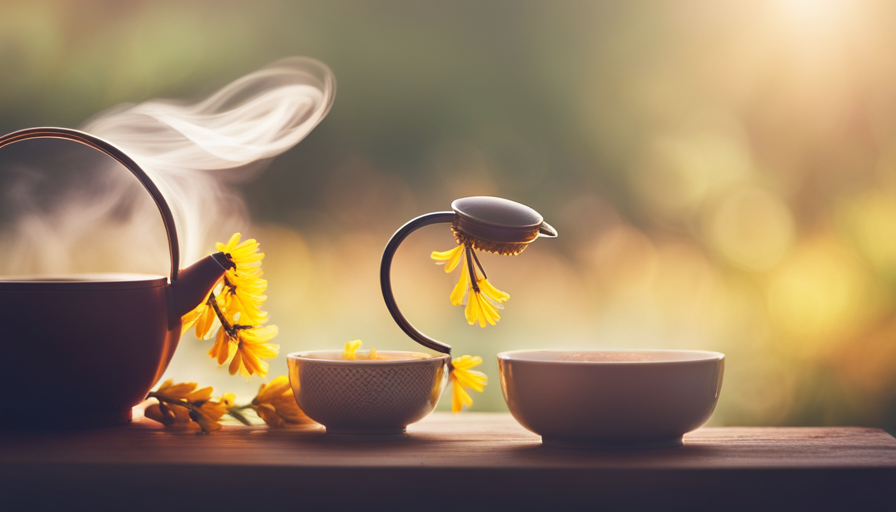
Picture yourself in a peaceful garden, enveloped by the bold hues and pleasant fragrance of blossoming flowers. While you absorb the beauty in your surroundings, a soft breeze wafts the subtle scent of mimosa flowers, prompting you to discover their captivating allure.
Did you know that you can transform these lovely blossoms into a soothing and flavorful tea? In this article, I will guide you through the process of making mimosa flower tea, step by step.
Mimosa flower tea not only offers a delightful and refreshing beverage, but it also holds numerous health benefits. From its calming properties to its potential to boost the immune system, this tea is a true gift from nature.
With just a few simple ingredients and a little patience, you can create a cup of tea that will transport you to a state of tranquility.
So, let’s embark on this floral journey together and learn how to make the perfect mimosa flower tea. Gather your tea equipment, prepare the flowers, and follow the steps outlined in this article. Get ready to savor the delicate flavors and experience the soothing effects of this enchanting brew.
Key Takeaways
- Mimosa flower tea offers a delightful and refreshing beverage.
- It has calming properties and can help alleviate anxiety and stress.
- Mimosa flower tea is rich in antioxidants and can boost the immune system.
- Experiment with different flavor combinations and sweeteners to find your preferred taste.
Gather Fresh Mimosa Flowers
Gather up those fresh mimosa flowers and get ready to brew some delicious tea! Mimosa flowers, also known as silk tree flowers, aren’t just beautiful, but they also have numerous uses. One of the best ways to enjoy the benefits of these flowers is by making mimosa flower tea.
Mimosa flower tea isn’t just a delightful beverage, but it also offers various health benefits. The tea is known for its calming properties, making it a perfect choice for those looking to relax and unwind. It can also help alleviate anxiety and stress, promoting better sleep and overall well-being. Additionally, mimosa flower tea is rich in antioxidants, which can boost your immune system and protect your body against harmful free radicals.
To make this soothing tea, start by gathering fresh mimosa flowers. Make sure the flowers are clean and free from any dirt or debris. You can harvest the flowers either early in the morning or in the evening when they’re fully bloomed. Once you’ve collected the flowers, gently rinse them under running water to remove any impurities.
Now that you’ve gathered your fresh mimosa flowers, it’s time to prepare your tea equipment. Transitioning into the next section, let’s get everything ready for brewing the perfect cup of mimosa flower tea.
Prepare Your Tea Equipment
First, you’ll need to assemble the necessary equipment, such as a teapot, strainer, and teacups, to enhance your tea-drinking experience. Did you know that using a teapot, instead of brewing tea directly in a cup, can help retain the tea’s flavor and aroma better? Choosing the best tea equipment is essential to ensure a delightful tea-drinking experience. Here are some key points to consider:
- Opt for a teapot made of glass or ceramic to allow better heat retention.
- Look for a fine mesh strainer to prevent any small flower particles from entering your tea.
- Use teacups made of porcelain or ceramic to maintain the temperature of the tea for a longer time.
- Consider investing in a tea infuser or a tea ball if you prefer loose tea leaves instead of flowers.
- Look for a teapot with a heat-resistant handle for comfortable pouring.
Using fresh mimosa flowers for your tea brings numerous benefits. Fresh flowers provide a vibrant taste and aroma that can’t be matched by dried flowers. The natural oils and flavors in the fresh flowers infuse into the tea, creating a truly refreshing experience.
Now that your equipment’s ready, let’s move on to rinsing the flowers.
Rinse the Flowers
To enhance your tea-drinking experience, it’s time to give those beautiful blossoms a quick rinse. Before steeping the mimosa flowers, it’s essential to remove any dirt and debris that may have accumulated on them. This step ensures that you have a clean and pure tea, free from any unwanted particles. However, it’s important to avoid over rinsing the flowers, as this can wash away the delicate flavors and aromas that make mimosa flower tea so delightful.
To achieve the perfect rinse, follow these simple steps:
- Fill a bowl with cool water.
- Gently place the mimosa flowers into the water.
- Swirl the flowers around in the water, allowing any dirt or debris to loosen and float away.
- Carefully lift the flowers out of the water and transfer them to a colander or strainer to drain excess water.
By rinsing the mimosa flowers, you ensure that your tea will be clean and free from any unwanted elements. With this step completed, we can move on to the next stage of making the perfect mimosa flower tea: boiling the water.
Boil Water
Once you’ve got everything ready, it’s time to fire up the stove and get that water boiling. Boiling the water is a crucial step in making a delicious mimosa flower tea. Here are four different ways to infuse flavor into the boiled water and achieve optimal taste:
-
Add a slice of lemon: Squeeze the juice of a fresh lemon into the water and drop in the slice for a citrusy twist.
-
Use honey or agave syrup: Stir in a spoonful of honey or agave syrup to sweeten the water and enhance the floral notes of the mimosa flowers.
-
Add a cinnamon stick: Toss in a cinnamon stick to infuse a warm and comforting flavor into the water, perfect for a cozy tea experience.
-
Try ginger slices: Slice a piece of ginger and add it to the boiling water for a subtle and refreshing kick.
Boil the water for about 5 minutes to ensure optimal taste. This duration allows the flavors to meld together while extracting the maximum essence from the mimosa flowers. Once the water is boiled, it’s time to move on to the next step of steeping the flowers, where the magic truly happens.
Steep the Flowers
As the fragrant steam rises from the pot, the essence of the infused flavors intertwines with the boiling water, creating a tantalizing aroma that envelops the room. Steeping the flowers is a crucial step in making the perfect mimosa flower tea. There are different steeping methods that you can choose from depending on your preferences. To start, place the desired amount of dried mimosa flowers into a tea infuser or a tea bag. Bring water to a boil and then let it cool for a minute before pouring it over the flowers. Allow the flowers to steep for about 5-7 minutes to extract the delicate flavors and health benefits of the mimosa flowers. The longer you steep, the stronger the flavor will be.
Steeping Method:
| Time | Temperature | Flavor Intensity |
|---|---|---|
| 5 min | 200°F | Mild |
| 7 min | 200°F | Medium |
Mimosa flower tea offers numerous health benefits. It is known to have antioxidant properties that help fight free radicals and improve overall well-being. The tea is also believed to have calming effects, promoting relaxation and reducing stress. Additionally, it may aid digestion and relieve bloating.
Now that the flowers are steeped to perfection, it’s time to move on to the next step: adding sweetener (optional).
Add Sweetener (Optional)
Now, you can enhance the delightful essence of your brew by adding a touch of sweetness to elevate your tea-drinking experience. Here are some discussion ideas to consider when deciding on the perfect sweetener for your mimosa flower tea:
-
Health benefits of sweeteners in herbal teas: Explore the advantages of using natural sweeteners like honey or stevia, which not only add sweetness but also offer nutritional benefits. Honey has antimicrobial properties and may help soothe a sore throat, while stevia is a zero-calorie option for those watching their sugar intake.
-
Alternatives to traditional sweeteners for mimosa flower tea: If you’re looking for unique flavors, consider trying agave nectar, maple syrup, or coconut sugar. These alternatives can add depth to your tea and provide additional health benefits. Agave nectar is low on the glycemic index, maple syrup contains antioxidants, and coconut sugar offers essential minerals like iron and zinc.
-
Experiment with flavor combinations: Think outside the box and try combining different sweeteners to create a personalized taste profile. For example, mixing honey and maple syrup can provide a harmonious blend of sweetness and richness.
-
Consider the tea’s natural sweetness: Before adding any sweetener, taste your mimosa flower tea to assess its inherent sweetness. You might find that it’s perfectly enjoyable without any additional sugar or sweetener.
-
Enjoying the tea with or without sweetener: Some tea enthusiasts prefer to savor the pure flavors of mimosa flower tea without any sweeteners. If you’re unsure, start with a small amount of sweetener and gradually adjust to find your preferred taste.
By adding a touch of sweetness, you can tailor your mimosa flower tea to suit your taste preferences. Now, let’s move on to the next step: straining the tea.
Strain the Tea
To strain your delightful brew, simply pour it through a fine mesh sieve or cheesecloth, allowing the smooth, fragrant liquid to flow into your cup, ready to be enjoyed. Straining the tea is an essential step in the process, as it helps remove any solid particles or residue, resulting in a cleaner and more visually appealing beverage. There are different types of strainers available, each with its own unique benefits.
One option is a fine mesh sieve, which effectively filters out even the smallest particles, ensuring a smooth texture and pure taste. Another popular choice is a cheesecloth, known for its ability to strain out larger particles while allowing the liquid to pass through easily. Both options provide excellent results, so it’s a matter of personal preference.
Straining the tea not only improves its appearance but also enhances the overall drinking experience. By removing any unwanted sediment or debris, you can fully appreciate the delicate flavors and aromas of the mimosa flower tea. It ensures that every sip is a delightful and refreshing experience.
Now that your tea is perfectly strained, it’s time to move on to the next step: serving and enjoying this delightful beverage.
Serve and Enjoy
Once the tea is perfectly strained, it’s time to savor and relish every sip of this delightful, fragrant beverage. The effort put into straining the tea pays off as you’re now ready to serve and enjoy the refreshing mimosa flower tea.
Here are some serving suggestions to enhance your tea experience:
- Serve the tea in delicate, transparent teacups to showcase its beautiful golden color.
- Accompany the tea with a plate of freshly baked scones or biscuits for a delightful pairing.
- Add a slice of lemon or a sprig of mint to enhance the flavor and aroma of the tea.
- For a touch of sweetness, drizzle a teaspoon of honey into each cup before pouring the tea.
- Serve the tea chilled over ice on a hot summer day for a cool and invigorating treat.
Not only does mimosa flower tea offer a delightful taste experience, but it also possesses several health benefits. It’s known for its calming properties, aiding in relaxation and stress relief. Additionally, it’s rich in antioxidants, which can boost the immune system and promote overall well-being.
Now that you’ve mastered the art of serving mimosa flower tea, it’s time to experiment with different variations to discover your favorite flavors.
Experiment with Different Variations
Indulge your taste buds and embark on a flavor-filled journey by exploring the diverse range of variations available for this exquisite beverage.
When it comes to flavor combinations to try with mimosa flower tea, the options are endless. For a refreshing twist, try adding a squeeze of lemon or a splash of orange juice to enhance the citrus notes of the tea. If you prefer a sweeter taste, a drizzle of honey or a sprinkle of cinnamon can do wonders. For a more floral aroma, add a few dried lavender buds or rose petals. The possibilities are truly limitless, allowing you to tailor the taste to your liking.
Not only is mimosa flower tea a delightful treat for your taste buds, but it also offers numerous health benefits. Packed with antioxidants, this tea can boost your immune system and help fight inflammation. It’s also known to promote relaxation and reduce stress levels, making it the perfect beverage to unwind after a long day.
As you savor the delightful flavors and reap the health benefits of mimosa flower tea, make sure to store the leftover tea properly to maintain its freshness.
Store Leftover Tea Properly
Storing the leftover tea properly is absolutely crucial to preserve its incredible flavors and ensure its freshness lasts for days. To prevent mold growth and maintain the quality of the tea, follow these simple steps:
-
Transfer the leftover tea to an airtight container: Pour the remaining tea into a glass or ceramic container with a tight-fitting lid. Avoid using plastic containers, as they may absorb the flavors and affect the taste of the tea.
-
Refrigerate the tea promptly: Place the sealed container in the refrigerator immediately after making it. The cold temperature helps slow down the growth of bacteria and maintains the tea’s freshness.
-
Consume within 3 days: While the tea can last up to a week in the refrigerator, it’s recommended to consume it within three days for the best flavor. After that, the taste may start to deteriorate.
-
Reusing leftover tea: If you have leftover tea that you don’t want to drink as is, there are various ways to repurpose it. You can use it as a base for iced tea, add it to smoothies, or even use it as a flavorful ingredient in baking recipes.
By following these simple steps, you can ensure that your leftover mimosa flower tea remains fresh, flavorful, and free from mold growth.
Frequently Asked Questions
How long should I steep the mimosa flowers for?
For the best results, I recommend steeping the mimosa flowers for about 5 to 7 minutes. This allows enough time for the flavors and health benefits to infuse into the tea.
Steeping the flowers for too long may result in a bitter taste, so it’s important to keep an eye on the time.
Mimosa flower tea is known for its calming properties and can help reduce anxiety and promote relaxation.
Can I use dried mimosa flowers instead of fresh ones?
Absolutely! You can use dried mimosa flowers instead of fresh ones. They retain their aromatic properties and are convenient to have on hand for making tea blends. Incorporating dried mimosa flowers into other tea blends adds a delightful floral note. Moreover, drinking mimosa flower tea offers numerous benefits. It can help reduce anxiety, promote relaxation, and even aid in digestion. So, go ahead and enjoy the wonderful flavors and benefits of dried mimosa flowers in your tea!
What are some variations I can try with the mimosa flower tea?
There are several different ways to infuse flavors into mimosa flower tea, allowing for a diverse range of tastes. One option is to add a slice of fresh lemon or orange to the tea for a citrusy twist. Another variation is to incorporate a teaspoon of honey or a sprinkle of cinnamon for added sweetness and warmth. These variations not only enhance the flavor profile but also offer additional health benefits, such as boosting immune function and reducing inflammation.
Can I add milk or cream to the mimosa flower tea?
Yes, you can add milk or cream to your mimosa flower tea. While traditionally, mimosa flower tea is enjoyed on its own, adding milk or cream can create a creamy and comforting drink. The milk or cream will enhance the taste and texture of the tea, making it a delightful treat.
It’s important to note that while milk or cream may alter the flavor slightly, the health benefits of mimosa flower tea, such as its antioxidant properties, will remain intact.
How long can I store the leftover mimosa flower tea?
The shelf life of leftover mimosa flower tea can vary depending on how it’s stored. On average, you can store it in the refrigerator for up to 2-3 days. However, if you want to extend its shelf life, you can try preserving methods like freezing it in ice cube trays or using airtight containers. Freezing can help retain its flavor and freshness for up to 2-3 months. Just make sure to thaw it properly before consuming.
Conclusion
In conclusion, making mimosa flower tea is a delightful and rewarding experience. By following the steps outlined above, you can create a soothing and fragrant beverage that’ll transport you to a tranquil garden filled with blooming flowers.
Just like a gentle breeze, this tea’ll calm your senses and leave you refreshed. So, gather your Mimosa flowers, prepare your equipment, and embark on this botanical journey.
Cheers to exploring the world of herbal teas!
Flower Tea
How To Dry Passion Flower For Tea

Have you ever tried the gentle and calming flavors of passion flower tea? If not, you’re in for a pleasant surprise! Passion flower tea is not only tasty but also comes with a variety of health benefits. Today, I will walk you through the steps of drying passion flowers to create your own homemade passion flower tea.
Symbolically, passion flowers are known for their ability to evoke a sense of tranquility and relaxation. By harnessing the power of these beautiful flowers, we can create a tea that promotes a calm and peaceful state of mind.
Drying passion flowers is a simple yet crucial step in the tea-making process. It allows us to preserve the flowers’ natural flavors and medicinal properties. In this article, I will share with you the step-by-step instructions on how to dry passion flowers effectively.
So, get ready to embark on a journey of tea-making and self-care. Let’s dive in and discover the art of drying passion flowers for a truly exquisite tea experience.
Key Takeaways
- Choose well-ventilated area with low humidity for drying passion flowers
- Harvest passion flowers when petals have fully opened and flower is in full bloom for highest concentration of essential oils and beneficial compounds
- Different drying techniques include air drying, dehydrating, oven drying, and microwave drying
- Remove stems and leaves from dried flowers to enhance flavor and preserve aroma
Choose the Right Passion Flower Variety
To ensure a high-quality tea, you’ll want to select the appropriate passion flower variety for drying. Choosing the right passion flower variety is crucial because different varieties have varying levels of potency and flavor profiles.
When growing passion flowers in containers, it’s important to choose a variety that is well-suited for this method of cultivation. Some varieties, such as Passiflora incarnata or Passiflora edulis, thrive in containers and are easy to care for. These varieties also produce beautiful flowers, making them a great choice for ornamental purposes as well.
In addition to their beauty, passion flowers have been used in herbal remedies for centuries. Certain varieties, like Passiflora incarnata, have calming properties that can help reduce anxiety and promote relaxation. By selecting a variety with these medicinal qualities, you can not only enjoy a delicious tea but also experience the potential health benefits that passion flowers offer.
Now that you understand the importance of choosing the right passion flower variety, let’s move on to the next step: harvesting the passion flowers at the right time.
Harvest the Passion Flowers at the Right Time
Harvesting the passion flowers at the right time ensures the best flavor and aroma for your homemade herbal infusion. To achieve the optimal taste and fragrance, it’s important to pick the flowers at their peak ripeness. The best time to harvest passion flowers for drying is when the petals have fully opened and the flower is in full bloom.
At this stage, the flowers contain the highest concentration of essential oils and other beneficial compounds.
To preserve the flavor and aroma of the passion flowers, it’s crucial to employ proper drying techniques. Here are some key points to consider:
- Choose a well-ventilated area with low humidity to dry the flowers.
- Avoid direct sunlight, as it can degrade the delicate compounds.
- Gently remove any excess moisture from the flowers before drying.
- Arrange the flowers in a single layer on a clean, dry surface.
By following these drying techniques, you can retain the vibrant flavor and aroma of the passion flowers, resulting in a more enjoyable tea experience.
Now that the flowers are harvested, the next step is to wash them thoroughly to remove any dirt or insects that may be present.
Wash the Passion Flowers Thoroughly
Now that you’ve got those beautiful passion flowers in your possession, it’s time to give them a good, thorough wash to make sure they’re as clean as can be for your ultimate infusion experience! Properly washing the passion flowers is an essential step in preparing them for use as a natural remedy, such as making passion flower tea. Here’s how to do it.
First, gently rinse the passion flowers under cool running water to remove any dirt or debris. Be sure to handle them delicately to avoid damaging the delicate petals and leaves.
Next, fill a large bowl with water and add a few drops of mild dish soap. Submerge the passion flowers in the soapy water and gently swish them around to remove any remaining impurities. Allow them to soak for a few minutes.
After soaking, rinse the passion flowers thoroughly under cool water to remove any soap residue. Ensure that all traces of soap are gone, as they can affect the taste and quality of the tea. Pat the flowers dry with a clean towel or allow them to air dry for a few hours.
Now that the passion flowers are clean and dry, it’s time to move on to the next step. Place them in a well-ventilated area to dry completely, ensuring they’re not exposed to direct sunlight or excessive heat. This will allow the flowers to retain their beneficial properties, making them ideal for creating passion flower tea that can aid in sleep.
Dry the Passion Flowers in a Well-Ventilated Area
Once the passion flowers have been thoroughly washed, it’s essential to allow them to air dry in a well-ventilated area to preserve their beneficial properties. Drying passion flowers is a crucial step in creating flavorful and aromatic tea. Proper drying techniques ensure that the flowers retain their vibrant color and distinct flavor. To achieve this, it is important to find a well-ventilated area where the flowers can dry naturally. This could be a sunny room or a shaded spot outdoors. The ventilation helps prevent moisture buildup, which could lead to mold or mildew.
To highlight the importance of proper drying, let’s take a look at the table below:
| Drying Techniques | Benefits |
|---|---|
| Air drying | Preserves color and flavor |
| Dehydrator | Retains more nutrients |
| Oven drying | Quick and efficient |
| Microwave drying | Requires less time |
By selecting the appropriate drying method, you can ensure that your passion flowers maintain their vibrant color and robust flavor. Once the flowers are completely dry, it’s time to move on to the next step: removing the stems and leaves from the dried flowers. This process allows for easier preparation and brewing of the passion flower tea.
Remove the Stems and Leaves from the Dried Flowers
To prepare your passion flower tea, you’ll want to remove the stems and leaves from the dried flowers, allowing for easier brewing and a more enjoyable tea-drinking experience. Did you know that this step can significantly enhance the flavor and aroma of your homemade tea?
Here are three reasons why removing the stems and leaves is important:
-
Enhanced Flavor: By separating the dried flowers from the stems and leaves, you can fully appreciate the delicate and unique taste of passion flower tea. The stems and leaves can sometimes impart a bitter or earthy flavor, which may not be desirable for everyone.
-
Aroma Preservation: Removing the stems and leaves ensures that the floral scent of the passion flowers remains intact. This adds a pleasant and soothing fragrance to your tea, enhancing the overall sensory experience.
-
Alternative Uses: Don’t discard those stems and leaves just yet! They can be repurposed in various ways. You can use them to make herbal infusions, add them to bath salts for a relaxing soak, or even incorporate them into potpourri for a natural and aromatic home fragrance.
Once you’ve removed the stems and leaves from the dried flowers, it’s time to store them in an airtight container to maintain their freshness.
Store the Dried Passion Flowers in an Airtight Container
Make sure you seal the dried passion flowers in an airtight container to preserve their freshness and maintain their delicate aroma.
Storing dried passion flowers properly is essential in order to enjoy a flavorful and aromatic cup of passion flower tea. To maximize the shelf life of your dried passion flowers, it’s important to follow the right storing techniques and preservation methods.
Firstly, choose a container that’s airtight and opaque to protect the dried flowers from exposure to light and air. This’ll help prevent oxidation and maintain the potency of the passion flowers. Glass jars or metal tins with tight-fitting lids work well for this purpose. Make sure the container’s clean and dry before transferring the dried flowers into it.
Next, place the dried passion flowers into the container, making sure not to crush or break them. It’s advisable to keep the flowers whole until you’re ready to brew the tea, as this helps retain their essential oils and flavor.
Store the airtight container in a cool, dark, and dry place, such as a pantry or cupboard. Avoid storing the container near heat sources or in direct sunlight, as this can degrade the quality of the flowers.
When it’s time to prepare the passion flower tea, simply open the container and take out the desired amount of dried flowers. Transitioning to the subsequent section about ‘prepare the passion flower tea,’ you can now begin brewing a soothing cup of tea with these perfectly preserved dried passion flowers.
Prepare the Passion Flower Tea
Get ready to indulge in a cup of pure relaxation by steeping those beautifully preserved dried passion flowers in hot water. Passion flower tea not only offers a delightful taste but also provides numerous benefits for your well-being.
Benefits of drinking passion flower tea:
- Calming effects: Passion flower tea is known for its calming properties, helping to reduce anxiety and promote relaxation. Its natural compounds, such as flavonoids and alkaloids, work together to soothe the mind and body.
- Improved sleep: Sip on a warm cup of passion flower tea before bed to promote better sleep. Its sedative properties help alleviate insomnia and encourage a peaceful night’s rest.
- Enhanced digestion: Passion flower tea can aid digestion by relieving indigestion, bloating, and stomach cramps. It stimulates the production of digestive enzymes, promoting a healthy digestive system.
How to make passion flower tea taste better:
- Add honey or stevia: Sweeten your passion flower tea with a touch of honey or stevia to enhance its flavor without adding any artificial sugars.
- Experiment with citrus: Squeeze a fresh lemon or orange into your tea for a tangy twist. The citrusy notes complement the floral taste of the passion flower.
- Mix with other herbal teas: Blend passion flower tea with chamomile or lavender to create a soothing and aromatic infusion.
Now that you know the benefits and how to improve the taste of passion flower tea, it’s time to experiment with different brewing methods and recipes to find your perfect cup of tranquility.
Experiment with Different Brewing Methods and Recipes
After preparing the Passion Flower Tea, it’s time to delve into the exciting world of experimenting with different brewing methods and recipes. This is where you can truly showcase your creativity and explore the full potential of passion flower as a tea ingredient. By varying brewing techniques and trying out unique flavor combinations, you can create a tea that caters to your personal taste preferences.
To help you in this journey, I have prepared a table below that outlines different brewing methods and flavor combinations you can try:
| Brewing Method | Flavor Combination |
|---|---|
| Steeping | Passion flower with chamomile |
| Infusion | Passion flower with lavender |
| Decoction | Passion flower with lemon and mint |
| Cold brewing | Passion flower with hibiscus |
| Blending | Passion flower with rose petals |
Each method and combination will yield a different taste profile, allowing you to discover your favorite way to enjoy passion flower tea. Remember to adjust the brewing time and temperature according to the method you choose to ensure optimal flavor extraction.
Now that you have explored the various brewing techniques and flavor combinations, you are ready to dive into the next section and learn about the health benefits of passion flower tea.
Enjoy the Health Benefits of Passion Flower Tea
Now you can savor the delightful taste of passion flower tea while reaping its numerous health benefits, like a refreshing breeze on a warm summer day. Passion flower tea isn’t just a delicious beverage but also offers several health advantages. It’s known for its calming properties and is often used as a natural remedy for anxiety and insomnia.
The tea contains flavonoids and alkaloids that interact with certain receptors in the brain, promoting relaxation and reducing stress levels. Studies have shown that passion flower tea can also help improve sleep quality. It’s believed to increase the levels of gamma-aminobutyric acid (GABA) in the brain, a neurotransmitter that helps regulate sleep. By promoting relaxation and reducing anxiety, passion flower tea can help individuals fall asleep faster and stay asleep longer.
Furthermore, passion flower tea is rich in antioxidants, which can help protect the body against damage from harmful free radicals. These antioxidants have been linked to a reduced risk of chronic diseases, such as heart disease and certain types of cancer.
In terms of brewing techniques, the best way to enjoy the health benefits of passion flower tea is to steep the dried leaves in hot water for about 10 minutes. This allows the beneficial compounds to be extracted, resulting in a flavorful and nutritious beverage.
As you explore the world of passion flower tea and discover its many benefits, you may find yourself wanting to share your experience with others.
Share Your Passion Flower Tea Experience with Others
Indulge in the exquisite taste and health benefits of passion flower tea, and you’ll soon find yourself eager to share your delightful experience with others. Passion flower tea isn’t just a delicious beverage, but also a potent herbal remedy that promotes relaxation and relieves anxiety.
To make the most of this wonderful tea, try experimenting with different blends and flavors. Personally, one of my favorite passion flower tea blends is a combination of passion flower, chamomile, and lavender. The floral notes of these herbs complement each other perfectly, creating a calming and aromatic blend that’s perfect for winding down after a long day.
When it comes to incorporating passion flower tea into your daily routine, there are a few tips to keep in mind. Firstly, it’s important to note that passion flower tea is best enjoyed in the evening, as it can have a mild sedative effect. Brewing a cup of passion flower tea before bed can help you relax and promote a restful night’s sleep.
Secondly, you can also try adding a splash of lemon or honey to your tea for an extra burst of flavor. Lastly, don’t forget to share your favorite passion flower tea blends with friends and family. It’s a great way to introduce them to the wonderful world of herbal teas and promote overall well-being.
So go ahead, brew a cup of passion flower tea and spread the joy!
Frequently Asked Questions
Can I use any variety of passion flower to make tea?
When it comes to making passion flower tea, not all varieties are created equal. The variety selection plays a crucial role in determining the taste and therapeutic properties of the tea. Different passion flower varieties may have varying levels of potency and flavor profiles. It’s important to choose a variety that’s specifically cultivated for tea-making purposes.
Additionally, brewing techniques such as steeping time and water temperature should be carefully considered to achieve the desired taste and benefits.
What happens if I harvest the passion flowers too early or too late?
If I were to harvest passion flowers too early or too late, there would be consequences in terms of the quality and potency of the tea. Optimal timing is crucial to ensure the flowers are at their peak in terms of flavor and medicinal properties.
Harvesting too early may result in a lack of aroma and potency, while harvesting too late may lead to a bitter taste and reduced medicinal benefits. It’s important to find the right balance to obtain the best results.
Is it necessary to wash the passion flowers before drying them?
Before drying passion flowers for tea, I highly recommend washing them. Similar to how we wash fruits and vegetables before consuming them, washing passion flowers ensures that any dirt, dust, or contaminants are removed.
Additionally, washing the flowers helps preserve their natural flavor and aroma during the drying process. By removing any potential impurities, we can fully enjoy the benefits of dried passion flowers, such as their soothing effects and potential antioxidant properties.
Can I dry the passion flowers in the sun or do I need a specific type of ventilation?
When drying passion flowers for tea, it’s important to consider the method of drying. Sun drying and proper ventilation are both viable options.
Sun drying involves placing the flowers in a sunny area to dry naturally, while ventilation requires using a well-ventilated space with air circulation.
Both methods have their benefits, but sun drying may result in a more potent flavor. Regardless of the method chosen, it’s crucial to ensure the flowers are fully dry before using them for tea.
How long can I store the dried passion flowers before they lose their flavor and potency?
To maximize the flavor and potency of dried passion flowers, proper storage is essential. Symbolically speaking, think of them as delicate treasures that need to be protected. Store them in an airtight container, away from light, heat, and moisture. This will help preserve their aroma and therapeutic properties. For longer shelf life, freezing is an option. Remember, the longer they’re stored, the more their flavor and potency may diminish, so it’s best to use them within a year.
Conclusion
In conclusion, drying passion flower for tea is a rewarding process that allows you to enjoy the numerous health benefits of this beautiful plant. By following the steps outlined in this article, you can ensure that your passion flower tea is of the highest quality.
Remember the old saying, "Good things come to those who wait." Just like a delicious cup of passion flower tea, patience and attention to detail are key. So go ahead, brew a cup and savor the soothing flavors and calming effects of this amazing herbal tea.
Cheers to good health!
-

 Tea Brewing and Preparation7 days ago
Tea Brewing and Preparation7 days agoThe Ultimate Guide To Authentic Yogi Tea: A Spiced Immune-Boosting Ayurvedic Delight
-
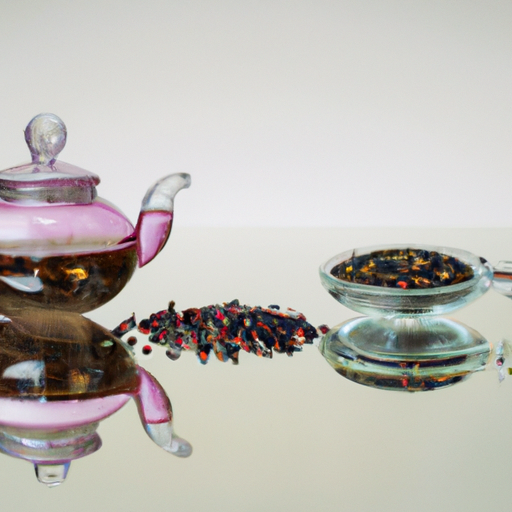
 Herbal Tea2 days ago
Herbal Tea2 days agoHow To Add Peppercorns To Herbal Tea Blends
-

 Turmeric Tea7 days ago
Turmeric Tea7 days agoIs Turmeric Good For Tooth Inflammation
-
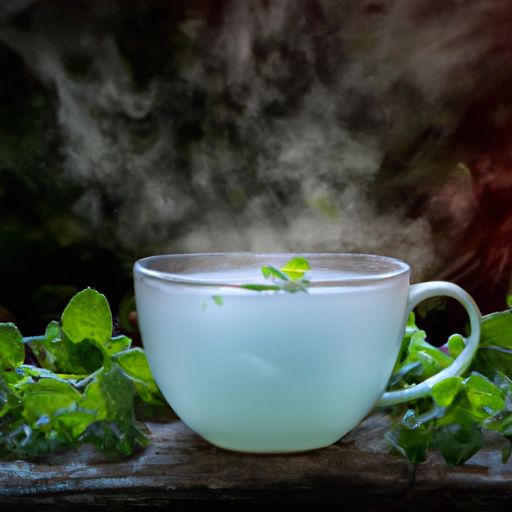
 Herbal Tea3 days ago
Herbal Tea3 days agoHow Does Peppermint Herbal Tea Help Clear Up A Cold
-

 Turmeric Tea7 days ago
Turmeric Tea7 days agoIs Turmeric Tea Good Before Bed
-

 Herbal Tea7 days ago
Herbal Tea7 days agoWhat Herbal Tea Is Good For Diverticulitis
-
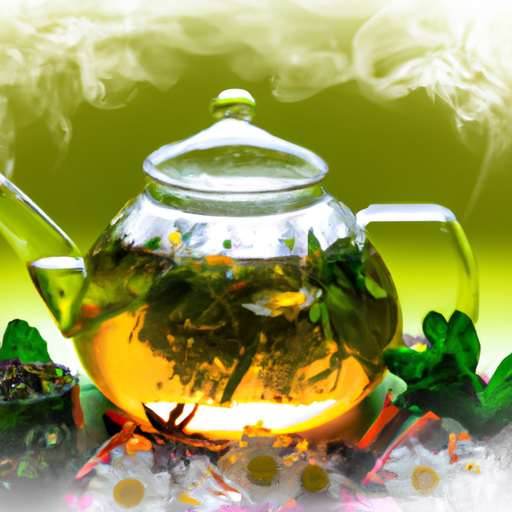
 Herbal Tea6 days ago
Herbal Tea6 days agoHow Much Potassium Is In Herbal Tea
-

 Herbal Tea3 days ago
Herbal Tea3 days agoHow Much Caffeine Does Berry Berry Herbal Tea Have In Iced Form




